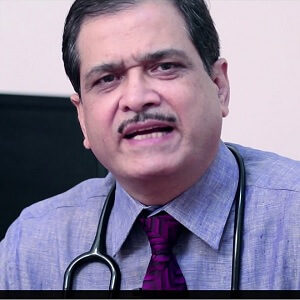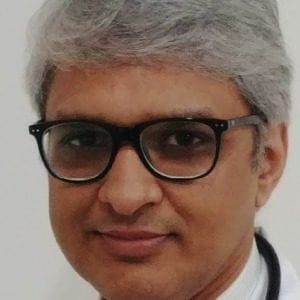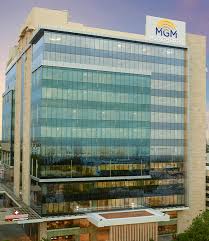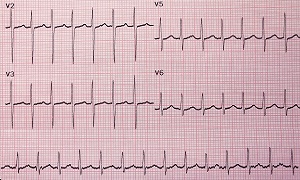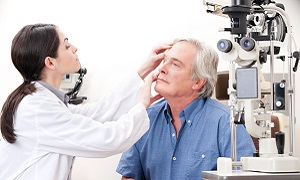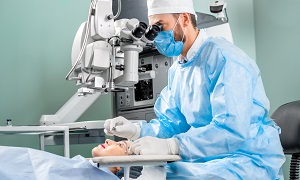Best Doctors in India for Marfan syndrome Treatment
- Top Interventional Cardiologist | Apollo Hospital, New Delhi, India
- 26+ Years Experience
- Indraprastha Apollo Hospital, New Delhi
Profile Highlights:
- Dr. Rajeev Kumar Rajput is one of the best Cardiologists in India with nearly 23 years of experience. He is a clinical cardiologist engaged in diagnosing and treating cardiovascular diseases.
- Dr. Rajput is currently working as a senior consultant with Indraprastha Apollo Hospitals, New Delhi, and also offers patient care at the Heart & Gynae Clinic.
- Dr. Rajeev Kumar Rajput specializes in Angiography and Interventional Cardiology. The treatments provided involve Neonatal and Infant cardiac surgeries, Device Closure, and Valve replacement. He has expertise in Aortic Aneurysm Surgery, Vascular Surgery, Percutaneous Coronary Interventions, Endovascular Repair, Cardiac Catheterisation, Open Heart Surgery, and MV replacement.
- Dr. Rajput is credited with publishing several papers in noted medical journals.
- Cardiologist, Gurugram, India
- Over 20 years’ experience
Profile Highlights:
- Dr. Vivek Chaturvedi is a highly experienced and acclaimed cardiologist with over 20 years of experience.
- He has performed more than 2500 cardiac ablations, several of them for complex arrhythmias like atrial tachycardia, ventricular tachycardia, VPC, and atrial fibrillation using the latest technology like 3D Electroanatomic mapping.
- He has more than 50 publications in international journals & books.
- Interventional Cardiologist, Chennai, India
- Over 15 years’ experience
- Apollo Hospitals Greams Road
Profile Highlights:
- Dr. Sai Satish is a distinguished Senior Interventional Cardiologist affiliated with Apollo Hospitals in India, renowned for his pioneering contributions to the field of transcatheter valve therapies.
- His expertise extends internationally, as he also serves as a practicing interventional cardiologist and esteemed faculty member at the Gottsegen Institute of Cardiology in Budapest, Hungary, one of the world’s leading centers for TAVR (transcatheter aortic valve replacement) training.
- A trailblazer in the realm of minimally invasive cardiovascular procedures, Dr. Satish is celebrated for performing the highest number of percutaneous edge-to-edge mitral repairs (MitraClip implants) in the Indian subcontinent.
Best Hospitals in India for Marfan syndrome Treatment
- City: New Delhi, India
Hospital Highlights:
- Over the last 33 years, the Fortis Escorts Heart Institute has set new standards in cardiac treatment with groundbreaking research. It is now known around the world as a centre of expertise for Cardiac Bypass Surgery, Interventional Cardiology, Non-invasive Cardiology, Paediatric Cardiology, and Paediatric Cardiac Surgery.
- The hospital has cutting-edge laboratories that perform a wide range of diagnostic tests in Nuclear Medicine, Radiology, Biochemistry, Haematology, Transfusion Medicine, and Microbiology.
- Fortis Escorts Heart Institute boasts a diverse group of bright and experienced doctors who are backed up by a team of highly qualified, experienced, and devoted support professionals as well as cutting-edge equipment such as the recently installed Dual CT Scan.
- Approximately 200 cardiac doctors and 1600 personnel currently collaborate to manage over 14,500 admissions and 7,200 emergency situations each year. The hospital now has a 310-bed infrastructure, as well as five cath labs and a slew of other world-class amenities.
- City: Faridabad
Hospital Highlights:
In the sprawling city of Faridabad, where healthcare needs are diverse and ever-evolving, one institution has consistently stood out as a beacon of excellence in the field of medicine—Marengo Asia Hospital. Established with a vision to provide world-class healthcare services to the community it serves, Marengo Asia Hospital has emerged as a trusted name synonymous with quality, compassion, and innovation in healthcare.
- City: New Delhi, India
Hospital Highlights:
- Equipped with 650 beds, BLK-Max Super Speciality Hospital is the largest stand-alone private sector hospital in Delhi.
- With over 1500 healthcare providers and 150 globally renowned super specialists, the hospital is one of Asia’s largest BMT Centres. The hospital is known for having some of the best cancer doctors in the country.
- The hospital is NABH and NABL accredited and was inaugurated by the first Prime Minister of India. Pt. Jawahar Lal Nehru.
- City: Chennai, India
Hospital Highlights:
- Located in Chennai, India, MGM Healthcare is a top multispecialty hospital that provides all medical services under one roof.
- Since its founding in 2019, MGM Healthcare has quickly become a leading national referral centre, creating several innovative flagship initiatives.
- MGM Healthcare combines next-generation medical and digital technologies to provide better patient results.
- With 12 centres of excellence, more than 400 inpatient beds, 100 intensive care unit beds, and 24/7 emergency care, MGM Healthcare leaves no chance in redefining the patient experience in Chennai.
- MGM Healthcare boasts 250+ expert doctors across 30+ departments, including Cardiology, Pulmonology, Neurology, Obstetrics & Gynaecology, and more.
- They house 12 specialized Centres of Excellence, including Neurosciences, Orthopaedics, and Multi-Organ Transplantation.
- Their team of doctors, nurses, and paramedics works together to give every patient individualized treatment.
- City: Noida, India
Hospital Highlights:
- Fortis Hospital, Noida, stands as one of the oldest and most trusted healthcare institutions in the region, setting a benchmark for comprehensive medical care.
- As the second mega hub hospital in the Fortis Healthcare Group, Fortis Hospital, Noida, upholds a legacy of trust among more than 1.2 million patients. By integrating top-tier professionals with cutting-edge technology, the hospital delivers superior treatment across various medical disciplines.
- Specializing in advanced Neurosciences, Orthopedics, Kidney and Liver Transplant Programmes, Fortis Hospital, Noida has successfully performed over 1,500 transplants, solidifying its reputation as a leader in specialized medical interventions.
Marfan Syndrome
Marfan syndrome is an inherited disorder, which affects the connective tissue in the body, which gives support and strength to various parts of the body such as cartilage, blood vessels, etc. This syndrome usually affects the eyes, blood vessels, the heart and the skeleton.
Usually tall and skinny people are victims of this syndrome. They might also have disproportionately long arms, fingers, legs and toes. Sometimes this ailment can be mild and at other times, quite severe. The large blood vessel which carries blood from your heart to the rest of the body is called the aorta. If this gets affected, your condition might be life-threatening.
Treatment for Marfan syndrome usually includes medications to help keep the blood pressure low, to reduce strain on the aorta. It is also important to monitor it regularly and check for damage progression. Most people suffering from this ailment eventually require preventive surgery for repairing the aorta.
Symptoms of Marfan Syndrome
These signs and symptoms of this illness can vary greatly, even among family members. Though some people experience only mild effects, others can develop life-threatening complications. In many cases, the disease also gets worse as one age.
Some of the symptoms of Marfan syndrome:
- Tall and Slender Build
- A breastbone protruding outward or dipping inward
- Disproportionately long arms, fingers, and feet
- Heart murmurs
- Extreme nearsightedness
- Abnormally curved spine
- Flat feet
Causes and risk factors
Marfan syndrome is caused by a change in the gene which controls how the body makes fibrillin, which is an essential part of connective tissue that can help to make it strong and elastic.
Marfan syndrome happens equally among both genders. In most cases, this ailment is inherited from a parent. People with this ailment have a 50% risk of passing down to their offspring. In some people with this syndrome, the gene changes without a clear cause.
Diagnosis of Marfan Syndrome
Marfan syndrome can be quite challenging for doctors to diagnose, as many connective tissue disorder have similar signs and symptoms. Even among some members of the same family, the signs and symptoms of Marfan syndrome vary widely, both in features as well as severity.
Certain combinations of symptoms and family history need to be presented to confirm a diagnosis of Marfan syndrome. In some cases, a person might have some features of Marfan syndrome, though not enough of them for a diagnosis of the syndrome.
Heart Tests
When a doctor suspects Marfan syndrome, usually the first test that is recommended is an echocardiogram. With the use of sound waves, this test captures real-time images of your heart in motion. It checks the condition of your heart valves as well as the size of your aorta. There are also other heart imaging options such as computerized tomography scans as well as magnetic resonance imaging.
If you are diagnosed with Marfan syndrome, regular imaging tests will be required for monitoring the size and condition of your aorta.
Eye Tests
Eye exams that might be needed can include:
- Slit-lamp exam- This test checks for lens dislocation, a detached retina as well as cataracts. For this exam, your eyes will have to be dilated as well.
- Eye pressure test- To check for signs of glaucoma, your eye doctor might measure the pressure inside your eyeball by touching it with some kind of special tool. Usually, before this test, numbing eye drops are used.
Genetic Testing
Genetic testing is also often used for confirming the diagnosis of Marfan syndrome. If a Marfan mutation is found, family members can also be tested, to see if they are affected as well. You might consider talking to a genetic counselor, before you start a family, to see your chances of passing on Marfan syndrome to your future children.
Treatment options for Marfan Syndrome
There is no known permanent cure for Marfan syndrome and the treatment focuses on preventing the various complications of the ailments. For achieving this, you need to be checked regularly for signs that the damage caused by the disease is progressing.
In the past, people suffering from Marfan syndrome usually died young. But with modern treatment as well as regular monitoring combined, people suffering from this syndrome can live up to a normal life span.
Medications
Therapy
Surgery and Other Procedures
Depending upon the signs and symptoms, procedures might include:
Aortic repair

If you aorta’s diameter reaches around 2 inches or if it enlarges quickly, your doctor might recommend an operation for replacing a portion of your aorta with a synthetic tube. This will help to prevent a rupture which can be life-threatening. Your aortic valve might also require replacement.
Scoliosis treatment
When there is significant scoliosis, a consultation with a spine expert is important. In some cases, bracing and surgery might be needed.
Breastbone corrections
For correcting the appearance of a sunken or protruding breastbone, one can choose to go for surgery. However, one should remember that these operations are considered to be for cosmetic purposes and therefore, your insurance may not cover your costs.
Eye Surgeries
Complications
Marfan syndrome can affect several parts of the body, leading to various kinds of complications, some of them including-
- Damage to the aorta: This can be considered one of the biggest threats of Marfan syndrome. Your aorta is the artery that carries blood from your heart to the rest of your body. Marfan syndrome can break open the aorta’s inner layers and cause dissection or bleeding in the wall of the vessel. Aortic dissection might be deadly. You might also require surgery for replacing the aorta’s affected parts.
- Mitral valve prolapse: Some people who suffer from Marfan syndrome also have a condition that causes billowing of the heart valve. This may be linked with uneven or rapid heartbeats as well as shortness of breath. It might need surgery.
- Lens dislocation: The lens in our eye, which focuses on your vision, might move out of place, which leads to a condition called ectopia lentis.
- Glaucoma or cataracts: Marfan syndrome can increase your chances of getting eye ailments like cataracts or glaucoma at an early age.
- Skeletal issues: People with this syndrome are also more likely to have a curved spine, unusual ribs, back pain and foot pain.
- Pregnancy complications: Because pregnancy increases the amount of blood in the body and aorta which is weakened by Marfan syndrome is at a higher risk of a rupture or dissection during pregnancy.

